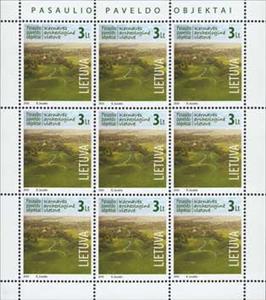Mini Sheet: The archaeological site of Kernavė (Lithuania 2010)
The archaeological site of Kernavė (Lithuania 2010)
07 August (Lithuania ) within release The World Heritage Objects. Archaeological Site of Kernave goes into circulation Mini Sheet The archaeological site of Kernavė face value 9*3 Lithuanian litas
| Mini Sheet The archaeological site of Kernavė in catalogues | |
|---|---|
| Michel: | Mi: LT 1045KB |
Mini Sheet is square format.
Also in the issue The World Heritage Objects. Archaeological Site of Kernave:
- Stamp - The archaeological site of Kernavė face value 3;
- Stamp - The archaeological site of Kernavė face value 3;
- Mini Sheet - The archaeological site of Kernavė face value 9*3;
- Mini Sheet - The archaeological site of Kernavė face value 9*3;
Mini Sheet The archaeological site of Kernavė it reflects the thematic directions:
Archaeology or archeology[a] is the study of human activity through the recovery and analysis of material culture. The archaeological record consists of artifacts, architecture, biofacts or ecofacts, sites, and cultural landscapes. Archaeology can be considered both a social science and a branch of the humanities. It is usually considered an independent academic discipline, but may also be classified as part of anthropology (in North America – the four-field approach), history or geography
The United Nations Educational, Scientific and Cultural Organization (UNESCO; pronounced /juːˈnɛskoʊ/) is a specialized agency of the United Nations (UN) with the aim of promoting world peace and security through international cooperation in education, arts, sciences and culture. It has 194 member states and 12 associate members,as well as partners in the non-governmental, intergovernmental and private sector. Headquartered in Paris, France, UNESCO has 53 regional field offices and 199 national commissions


